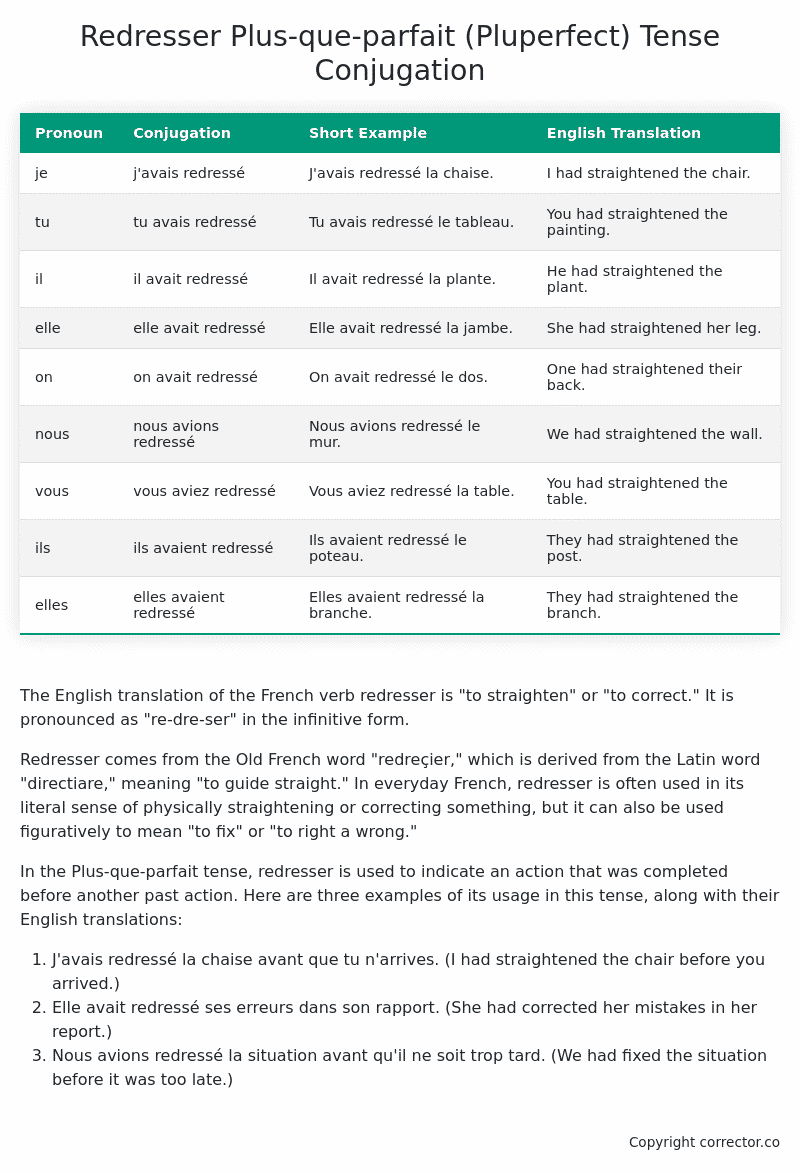Plus-que-parfait (Pluperfect) Tense Conjugation of the French Verb redresser
Introduction to the verb redresser
The English translation of the French verb redresser is “to straighten” or “to correct.” It is pronounced as “re-dre-ser” in the infinitive form.
Redresser comes from the Old French word “redreçier,” which is derived from the Latin word “directiare,” meaning “to guide straight.” In everyday French, redresser is often used in its literal sense of physically straightening or correcting something, but it can also be used figuratively to mean “to fix” or “to right a wrong.”
In the Plus-que-parfait tense, redresser is used to indicate an action that was completed before another past action. Here are three examples of its usage in this tense, along with their English translations:
- J’avais redressé la chaise avant que tu n’arrives. (I had straightened the chair before you arrived.)
- Elle avait redressé ses erreurs dans son rapport. (She had corrected her mistakes in her report.)
- Nous avions redressé la situation avant qu’il ne soit trop tard. (We had fixed the situation before it was too late.)
Table of the Plus-que-parfait (Pluperfect) Tense Conjugation of redresser
| Pronoun | Conjugation | Short Example | English Translation |
|---|---|---|---|
| je | j’avais redressé | J’avais redressé la chaise. | I had straightened the chair. |
| tu | tu avais redressé | Tu avais redressé le tableau. | You had straightened the painting. |
| il | il avait redressé | Il avait redressé la plante. | He had straightened the plant. |
| elle | elle avait redressé | Elle avait redressé la jambe. | She had straightened her leg. |
| on | on avait redressé | On avait redressé le dos. | One had straightened their back. |
| nous | nous avions redressé | Nous avions redressé le mur. | We had straightened the wall. |
| vous | vous aviez redressé | Vous aviez redressé la table. | You had straightened the table. |
| ils | ils avaient redressé | Ils avaient redressé le poteau. | They had straightened the post. |
| elles | elles avaient redressé | Elles avaient redressé la branche. | They had straightened the branch. |
Other Conjugations for Redresser.
Le Present (Present Tense) Conjugation of the French Verb redresser
Imparfait (Imperfect) Tense Conjugation of the French Verb redresser
Passé Simple (Simple Past) Tense Conjugation of the French Verb redresser
Passé Composé (Present Perfect) Tense Conjugation of the French Verb redresser
Futur Simple (Simple Future) Tense Conjugation of the French Verb redresser
Futur Proche (Near Future) Tense Conjugation of the French Verb redresser
Plus-que-parfait (Pluperfect) Tense Conjugation of the French Verb redresser (this article)
Passé Antérieur (Past Anterior) Tense Conjugation of the French Verb redresser
Futur Antérieur (Future Anterior) Tense Conjugation of the French Verb redresser
Subjonctif Présent (Subjunctive Present) Tense Conjugation of the French Verb redresser
Subjonctif Passé (Subjunctive Past) Tense Conjugation of the French Verb redresser
Subjonctif Imparfait (Subjunctive Imperfect) Tense Conjugation of the French Verb redresser
Subjonctif Plus-que-parfait (Subjunctive Pluperfect) Tense Conjugation of the French Verb redresser
Conditionnel Présent (Conditional Present) Tense Conjugation of the French Verb redresser
Conditionnel Passé (Conditional Past) Tense Conjugation of the French Verb redresser
L’impératif Présent (Imperative Present) Tense Conjugation of the French Verb redresser
L’infinitif Présent (Infinitive Present) Tense Conjugation of the French Verb redresser
Struggling with French verbs or the language in general? Why not use our free French Grammar Checker – no registration required!
Get a FREE Download Study Sheet of this Conjugation 🔥
Simply right click the image below, click “save image” and get your free reference for the redresser Plus-que-parfait tense conjugation!

Redresser – About the French Plus-que-parfait (Pluperfect) Tense
Tense Formation
Common everyday usage patterns
Sequencing of past events
Background information
Hypothetical or reported speech
Interactions with other tenses
Summary
I hope you enjoyed this article on the verb redresser. Still in a learning mood? Check out another TOTALLY random French verb conjugation!


